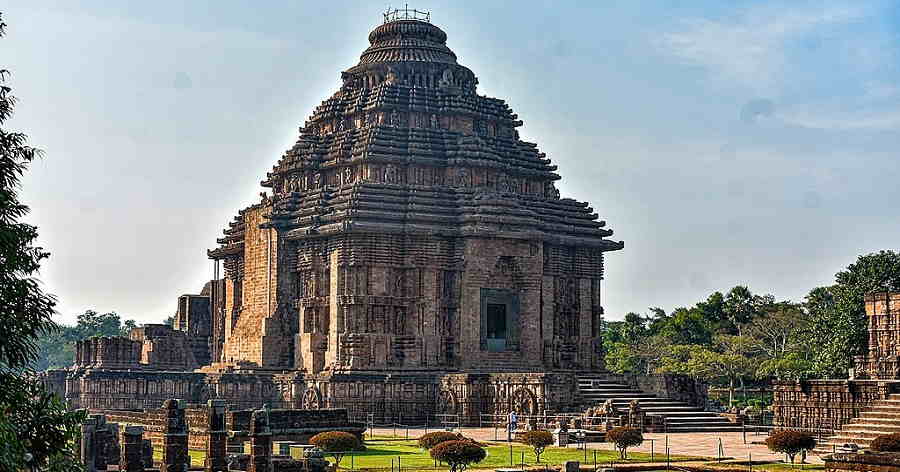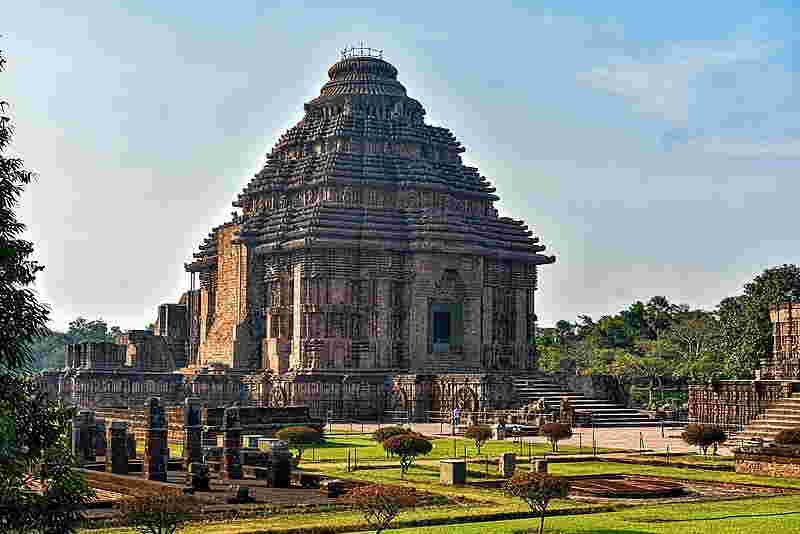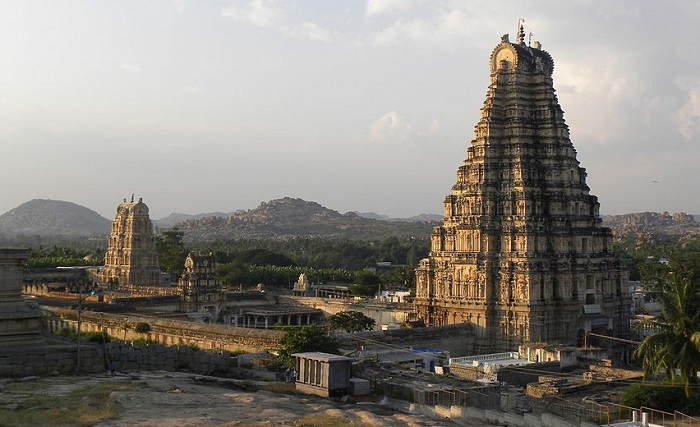

The Sun Temple in India is a spectacular example of ancient art and architecture. Built in the 13th century CE, it is a unique and impressive structure that stands as a testament to the skill and creativity of the people who constructed it. The temple is located in the city of Konark in the state of Odisha. It was built as a symbol of the Sun God, Surya, and is a magnificent example of the Hindu temple architecture that was popular during this period. The temple is designed in the form of a chariot, with twelve pairs of wheels and seven horses that are pulling it. At the front of the chariot is a large statue of the Sun God, Surya, and at the back is a huge wheel that symbolizes the rising and setting of the sun. The exterior of the temple is covered in intricately carved stone sculptures depicting various Hindu gods and goddesses, mythological characters, scenes from Hindu epics, and other symbols of religious significance. The walls of the temple are adorned with beautiful murals and sculptures of birds, animals, and humans. The interior of the temple is equally impressive, with its ornate pillars, intricate carvings, and detailed paintings. Its beauty and grandeur are unparalleled, and its intricate designs, breathtaking sculptures, and vibrant colors make it a true work of art.

The Benedictine Convent of Saint John at Mustair Switzerland is an ancient and beautiful building that dates back to the 9th century. Built as a monastery, it was originally dedicated to the Virgin Mary and Saint John the Baptist. Over the centuries, the convent has become known for its stunning and intricate collection of ancient art and architecture. The convent was constructed in the Romanesque style of the Middle Ages and features large, impressive towers and intricate stone carvings. The walls of the convent are adorned with frescoes, including a famous painting of the Virgin Mary with the baby Jesus. There are also a number of sculptures throughout the convent, including a crucifix and a relief sculpture of Saint John the Baptist.
The convent is also home to a large collection of ancient manuscripts, including illuminated books of the Gospels, religious texts, and other important works. The library also contains a number of rare and valuable artifacts, such as a 15th century manuscript of the Rule of Saint Benedict and the oldest known version of the Swiss national anthem. The convent's chapel is home to a number of works of art, including a large fresco of the Last Supper that is said to have been painted by the Renaissance artist Gaudenzio Ferrari. The chapel also features a number of sculptures, including a wooden carving of the crucifixion. The Benedictine Convent of Saint John at Mustair Switzerland is a stunning example of medieval architecture and art. Its ancient frescoes, sculptures, manuscripts, and artifacts are a testament to the rich history and culture of the region and a reminder of the importance of preserving our heritage.
-hungary_1926.jpg)
The Early Christian Necropolis of Pecs (Sopianae) Hungary is an early Christian burial site dating from the 4th and 5th centuries. It is located in the city of Pecs, in south western Hungary. The site is renowned for its rich collection of ancient art, which includes a variety of objects such as sarcophagi, reliefs, and tombstones. The most remarkable pieces of art found in the necropolis are the sarcophagi. These sarcophagi are decorated with reliefs featuring religious or mythological scenes. These reliefs are often intricately carved and depict events such as the Resurrection of Jesus, the Ascension of Elijah, or the martyrdom of the saints. These reliefs provide insight into the beliefs and values of the Early Christians that lived in the area. The tombstones are also of great artistic value. These tombstones are decorated with reliefs depicting the deceased, often in the form of a bust. The reliefs also often feature religious symbols such as the cross or a dove, symbolizing life after death. The tombstones are a testament to the importance of religion in the life of the Early Christians. The necropolis is also home to a number of sculptures and reliefs depicting Christian themes. These sculptures and reliefs depict scenes such as the Crucifixion and the Last Supper. The sculptures are often quite detailed and provide a glimpse into the lives of the Early Christians. The Early Christian Necropolis of Pecs (Sopianae) Hungary is a unique site that provides insight into the beliefs and values of the Early Christians. The art found in the necropolis is a testament to the skill and creativity of the Early Christians and provides a fascinating look into their past.

The magnificent Virupaksha Temple in India is an ancient Hindu temple dedicated to Lord Shiva, and is located in the city of Hampi in Karnataka. The temple is a significant example of the ancient art and architecture of the Vijayanagara Empire, and is believed to have been built in the 7th century. The temple is a beautiful blend of the Dravidian, Chalukyan, and Hoysala styles of architecture, with intricate carvings and sculptures adorning the walls and pillars. The main entrance is a gopuram, a large ornate gateway which is intricately carved and brightly painted. The inner sanctum of the temple contains a large image of Lord Shiva in the form of Virupaksha.
The temple complex also includes several smaller shrines, dedicated to Shiva's consort Parvati, his sons Ganesha and Murugan, and his vehicle Nandi the bull. The temple is home to many beautiful sculptures, depicting various gods and goddesses, including Shiva, Parvati, Ganesha, and Vishnu. The walls and pillars of the temple are adorned with beautiful carvings and paintings depicting scenes from Hindu mythology, including the Ramayana and Mahabharata. There are also many sculptures of Shiva in various postures, each representing a different aspect of the god. The Virupaksha Temple is a unique example of ancient Indian art and architecture, and is a great representation of the art and culture of the Vijayanagara Empire. It has been declared a UNESCO World Heritage Site and is definitely worth a visit!

The Buddhist Vihara at Paharpur, Bangladesh, is an ancient art form that dates back to the 8th century CE. It is considered to be one of the most important Buddhist monuments in the world and a testament to the vibrant culture of the Pala Empire of Bengal. The Vihara consists of several structures, including a large main temple, a number of small shrines, and a monastery complex. The main temple is a massive brick structure that rises up to a height of nearly 40 feet. It is decorated with terracotta plaques, depicting scenes from the life of the Buddha, and a number of intricate floral and geometric designs. The walls of the main temple are adorned with terracotta plaques that depict incidents from the life of the Buddha, including his birth, his enlightenment, his first sermon, and his death. These plaques are believed to be some of the oldest surviving examples of Buddhist art in the world. The monastery complex consists of several cells, each one housing a monk's residence and meditation chamber. There are also a number of small shrines located throughout the complex, some of which are dedicated to the bodhisattva Avalokitesvara. The Vihara is a testament to the Pala Empire's great achievements in architecture and art, and a reminder of the strong spiritual tradition of Buddhism in the region. Its towering brick walls, intricate terracotta plaques, and numerous shrines make it an important archaeological site and a major tourist attraction.

The Urnes Stave Church in Norway is one of the oldest and best preserved of the existing stave churches in the country, and a masterpiece of ancient art. Built in the 12th century, the Urnes Stave Church is a beautiful example of Romanesque and Gothic architecture, and is believed to be the oldest of Norway’s 28 surviving stave churches. The stave church is a timber construction made from the trunks of pine trees, which were cut down to be used as vertical supports, or “staves”. The trunks were then joined together with horizontal beams and covered with a roof of cedar shingles. The exterior of the church is decorated with intricate carvings, such as dragons and other mythical creatures, and the interior is adorned with painted murals depicting scenes from the Bible.
The most impressive feature of the Urnes Stave Church is the intricate wooden carvings that adorn the exterior. These carvings represent scenes from Norse mythology, such as dragons and other mythical beasts. The wooden carvings on the exterior of the church are believed to be the oldest surviving examples of Norse art and are a testimony to the skill and craftsmanship of the people of the time. The interior of the church is decorated with painted murals which depict scenes from the Bible. The paintings are in a Romanesque style, and were likely added in the late 12th century. The murals are a representation of the life and teachings of Jesus, and are an example of the religious beliefs of the people of the time. The Urnes Stave Church is a remarkable example of ancient art and architecture, and a testament to the skill and craftsmanship of the people of the time.

Reichenau is an island located on the Rhine River in Germany and is home to many historical artifacts and ancient art. It has a rich history, with archaeological explorations revealing artifacts from the Neolithic, Bronze Age and Iron Age. The island is known for its Celtic and Roman art and artifacts, which have been found in many of the excavations around the island. The most famous ancient artifact on the island is the Celtic gold torc, which is a type of neck ornament made of twisted gold strands and was found in a burial mound on the island in 1902. This torc is believed to be from the late Iron Age, and is now on display in the Ludwigshafen Museum. Reichnau is also known for its Bronze Age artifacts, including the Schullehof bronze statue, which is a large bronze sculpture of a warrior mounted on a horse. This sculpture was discovered in a burial mound on the island in 1972 and is now exhibited in the Landesmuseum in Mainz. The island is also renowned for its Iron Age artifacts, such as the Iron Age pottery, which was discovered in a burial mound on the island in 1981. This pottery is believed to have been used for ritual purposes and is now exhibited in the Landesmuseum in Mainz.
Reichnau is also known for its ancient Roman artifacts, such as the Roman coins and jewelry, which were discovered in a burial mound on the island in 1984. These coins and jewelry are believed to have belonged to a Roman merchant who had settled on the island. In addition to archaeological artifacts, Reichnau is also home to many ancient artworks, such as the Celtic petroglyphs, which are rock engravings that were made by the Celts during the Iron Age. These petroglyphs are believed to be religious symbols and can be found on the island.